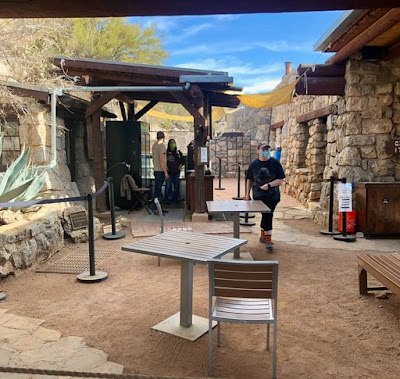The Titan Missile Museum, also known as Air Force Facility
Missile Site 8 or as Titan II ICBM Site 571-7, is a former Intercontinental Ballistic Missile (ICBM) site located at 1580 West Duval Mine
Road, Sahuarita, Arizona. It is located
about 25 miles south of Tucson on I-19. The museum is run by the nonprofit Arizona Aerospace Foundation and includes an inactive Titan II
intercontinental ballistic missile in the silo, as well as the original launch
facilities.
Officially known as complex 571-7, the
Titan Missile Museum is a National Historic Site and represents the last of the 54
Titan II transcontinental missile sites that were on alert across the United
States from 1963 to 1987.
The Martin Company first proposed
the development of the Titan II in 1958, and the Air Force approved the program October 1959. Construction of the launch complexes began in December 1960. The first missile was installed in December 1962, and the first
unit was turned over to the Strategic Air Command (SAC) on March 31, 1963.
Four important changes distinguished
the Titan II from its predecessors, the Atlas F and the Titan I. First,
the Titan II used nitrogen tetroxide (oxidizer) and unsymmetrical dimethyl
hydrazine (fuel) as its propellants. These liquids are hypergolic meaning that they do
not ignite until contact. This increased the reliability of the Titan
II, both at liftoff and when the Stage II engine ignited at high altitude.
Second, nitrogen tetroxide is
noncryogenic so that both propellants could be
stored on board the missile for indefinite periods of time.
Third, the Titan II would launch from its underground silo, reducing the launch time of the missile to
just under a minute.
Finally, the Titan II utilized an
all-inertial guidance system, increasing its
accuracy over the Titan I. Carrying the largest nuclear warhead ever deployed
on an ICBM by the United States, and with a range of 5,500 miles, the Titan II
was the ultimate liquid-propellant ICBM.
Classified as combat duty, Titan II
crew duty was only open to men when the systems became operational in
1963. That changed in 1978 when the Air Force opened the Titan II
career field to women. First Lieutenant Patricia M. Fornes was the first woman to pull a Titan II alert on September 16, 1978.
Each site
consisted of a missile silo, a launch control facility, and an access portal.
The sites were staffed 24 hours per day, 365 days per year, by a 4-person missile
combat crew who deployed to the missile sites for 24-hour shifts, called
alerts.  |
| Safety equipment for entering control central |
 |
| Heading into control central |
Each crew
pulled an average of 8 to 9 alerts a month, meaning they often worked the
equivalent of 5 weeks in a 4 week month. Crews consisted of two officers —
the Missile Combat Crew Commander (MCCC) and the Deputy Missile Combat Crew
Commander (DMCCC), along with two enlisted personnel — the Ballistic Missile
Analyst Technician (BMAT) and the Missile Facilities Technician (MFT).  |
| Control Central Panels |
 |
| Secured box holding launch codes |
 |
| Launch key |
Next you will walk down the cableway to level 2 of the missile silo for an up-close
look at the Titan II missile itself. If
you are lucky you may have a retired crew member as a tour guide as I
did on the day of my visit.  |
| Walkway to missile silo |
Note:
Visitors who are not able to descend and climb 55 stair steps for the guided
tour can still enjoy the surface portion of the missile site.
On the topside, you will see the
alarm systems, known as tipsies, that secure the missile silo door. You will be able to view the engine up-close. In addition, there is a spectacular view of the missile in the silo from above ground. Looking down into the 104-foot missile silo
you will see the Titan II Missile standing at attention as it did while on
alert for over 20 years.  |
Viewing area to missile silo
|
 |
Topside view
|
 |
Topside view
|
 |
Fueling tanks topside
|
 |
Engine on display topside
|
 |
| Fuel tank topside |
Browse the museum store during your visit. You can purchase Titan II,
Civil Defense, and other memorabilia, including pocket dosimeters
used to detect radiation, rebar salvaged from Titan II missile sites, and
replicas of an actual Titan II launch key. The store is also a good source of
educational toys and books, sweatshirts, tee shirts and caps.
Admission as of this blog article:
$13.50
for adults
$12.50
Seniors, Military and Pima County Residence
$10.00 Juniors age 5-1
$
1.00 Children 0-4
Check out the online interactive map for a better understanding of the
museum layout.
This is definitely a one-of-a kind museum that gives you a very rare look at the technology
used by the United States to deter nuclear war. What was once one of America’s
most top secret places is now a National Historic Landmark and open to the public.
If you have any interest in military,
the cold war or even star trek, you owe it to yourself to visit this
outstanding museum. This was truly an informative and amazing
experience.





















































